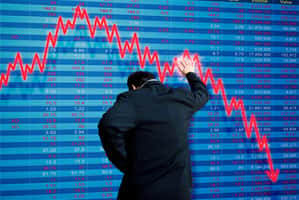New York-based market maker and liquidity services provider Virtu Financial (VIRT - Get Rating) has gained 48.4% over the past year. This can be attributed to elevated market volatility caused by the COVID-19 pandemic, which led to higher trading volumes across global markets and asset classes.
Higher trading activities spurred demand for Virtu’s services. However, because businesses have now begun resuming normal activities due to positive developments on the coronavirus vaccination front, market volatility levels are normalizing.
Furthermore, the current volatility of the U.S. dollar and fluctuations in currencies could have an impact on the company’s financial condition. So, we think VIRT’s near-term prospects look uncertain.
Here are the factors that we think could influence VIRT’s performance in the near term:
Normalizing Market Volatility
VIRT experienced elevated market volatility and trading levels due to the COVID-19 pandemic, which contributed positively to the company’s results. However, a decline in overall market volatility can now be seen in the S&P VIX Index’s 35.7% year-to-date decline to 17.33. VIRT’s business model is likely to face pressure from more normal volatility levels and lower trading volumes.
Strong Financials
VIRT delivered exceptional performance globally in the fourth quarter. The company’s market making segment played a critical role by seamlessly executing trades, and ultimately delivering $1.3 billion of price improvement to individual investors. Its revenues have increased 69.3% year-over-year to $676.70 million in the fourth quarter ended December 31, 2020. This was driven by the heightened volatility levels, bid-ask spreads and trading volumes across global markets and asset classes due to the COVID-19 pandemic. Its adjusted ebitda has risen 200.1% from its year-ago value to $343.90 million, while its EPS has also improved significantly to $0.88.
Currency Fluctuations Could Lead to Financial Uncertainty
A significant portion of VIRT’s international business is conducted in currencies other than the U.S. dollar. Although the company closely monitors potential changes in its financials because of currency fluctuations, it could not assure its success in managing its foreign exchange risk. Currently, the U.S. dollar is volatile. Given rising coronavirus infections in several countries and high money supply in the United States, many experts are of the opinion that currency fluctuations will continue through year’s end.
Unfavorable Growth Expectation
Analyst expects VIRT’s revenues to decline 40.1% year-over-year to $470.19 million in the current quarter, which ended March 31, 2021. A consensus EPS estimate of $1.11 for the first quarter represents a 45.9% decline from the year-ago value. Revenue and ESP for the current fiscal year are expected to decrease 32.7% and 45.3% year-over-year, respectively. Analysts further expect the company’s EPS to decline at a CAGR of 2.7% over the next five years.
POWR Ratings Don’t Indicate Enough Upside
VIRT has an overall C rating, which equates to Neutral in our POWR Ratings system. The POWR Ratings are calculated by considering 118 different factors with the weighting of each optimized to improve overall performance.
Our proprietary rating system also evaluates each stock based on eight different categories. VIRT has a C grade for Sentiment also, which is in sync with mixed analyst sentiment regarding the company’s prospects.
Moreover, VIRT has a B grade for Value. This is justified given its forward Non-GAAP price/earnings ratio of 9.87x, which is 21.9% lower than the industry average 12.63x. Also, its forward price/sales of 2.52x is 23% lower than the industry average 3.28x.
VIRT is ranked #49 of 104 stocks in the D-rated Financial Services (Enterprise) industry.
Click here to see VIRT’s POWR Ratings for Growth, Stability, Momentum, and Quality as well.
Better than VIRT: Click here to access top-rated stocks in the Financial Services (Enterprise) industry.
Bottom Line
Despite the stock delivering a decent return over the past year, VIRT’s growth potential looks weak given the near-term uncertainties related to its business environment, with normalizing volatility. So, we think investors should hold off on investing in VIRT for now.
Want More Great Investing Ideas?
9 “MUST OWN” Growth Stocks for 2021
How to Ride the NEW Stock Bubble?
5 WINNING Stocks Chart Patterns
Unlock the POWR in Your Portfolio!
VIRT shares were trading at $32.15 per share on Monday morning, up $0.65 (+2.06%). Year-to-date, VIRT has gained 28.83%, versus a 8.87% rise in the benchmark S&P 500 index during the same period.
About the Author: Rishab Dugar

Rishab is a financial journalist and investment analyst. His investment approach is to focus on quality stocks, trading at low prices, with business models that he readily understands. More...
More Resources for the Stocks in this Article
| Ticker | POWR Rating | Industry Rank | Rank in Industry |
| VIRT | Get Rating | Get Rating | Get Rating |






